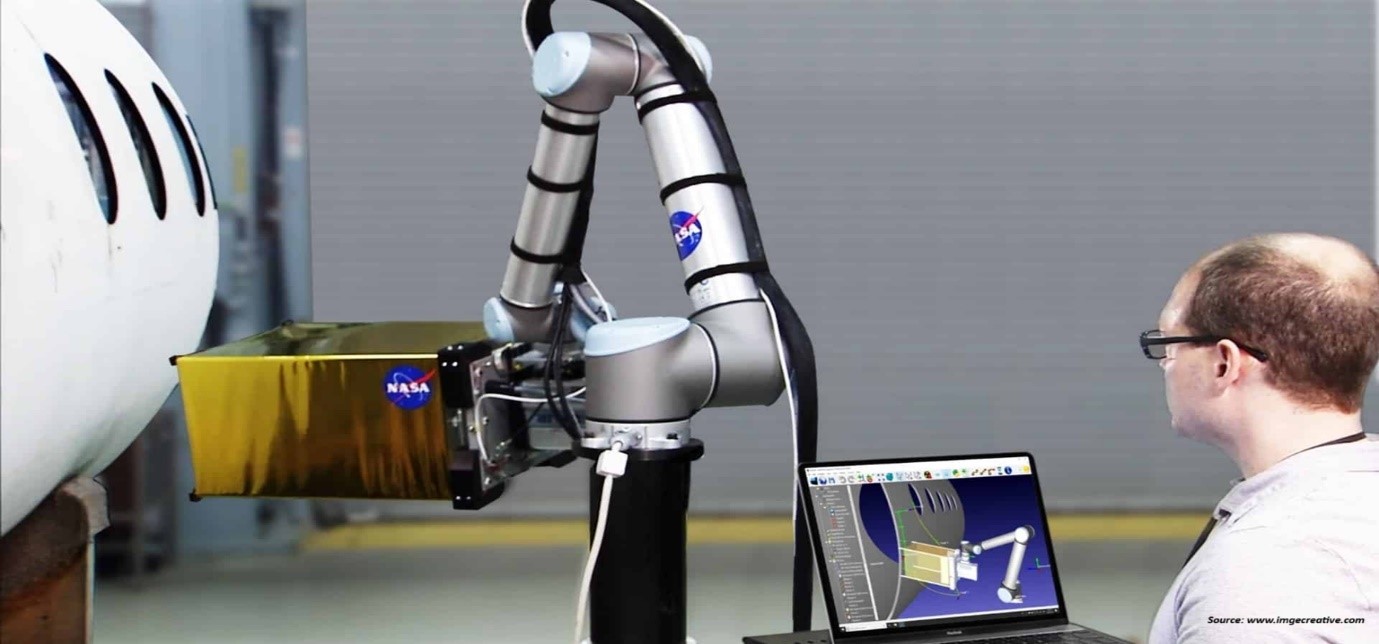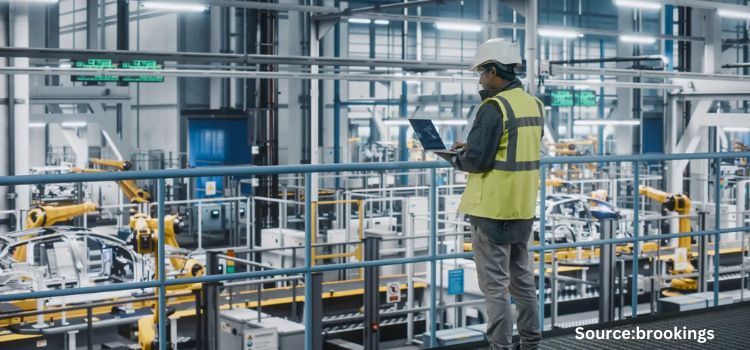
Cobot End Effector Market, by Type (Grippers, Suction Cups, Processing tools and Others), by Application (Handling, Assembling & Disassembling, Welding & Soldering, Dispensing, Processing and Other Applications), End User Industry (Automotive, Electronics, Metal & Machining, Plastics & Polymers, Food & Beverages, Furniture & Equipment, Healthcare and Other Industries)- Global Opportunity Analysis and Industry Forecast 2022-2030
Industry: ICT & Media | Publish Date: 11-Mar-2025 | No of Pages: 785 | No. of Tables: 464 | No. of Figures: 409 | Format: PDF | Report Code : IC410
US Tariff Impact on Cobot End Effector Market
Trump Tariffs Are Reshaping Global Business
Market Definition:
The global Cobot End Effector Market size was valued at USD 898.0 million in 2021 and is predicted to reach USD 2.66 billion by 2030 with a CAGR of 12.8% from 2022-2030. The cobot end effector is a type of equipment installed at the end of the collaborative robotic arm. It is that part of the cobot, which interacts with the environment and accomplishes a given task. They are actuated hydraulically, electrically, mechanically or pneumatically, and are available in different sizes and shapes. There are various types of end effectors such as grippers, force-torque sensors, material removal tools, welding torches, collision sensors, and tool changers. They are widely used in tasks such as picking, moving and placing dry or prepreg reinforcements. Also, they used to meet industrial process requirements such as painting, welding, inspection, assembly, and machine tending among others.
Market Dynamics and Trends:
The prime factor fueling the cobot end effector market growth is the adoption of collaborative robots in heavy and non-heavy industries owing to the increasing popularity of industry automation principles like Industry 4.0. Collaborative robots possess huge potential in industries as they can interact directly and safely with humans in a shared work-place certified according to the ISO / TS 15066 standard. Also, cobots provide high return on investments (ROI), and benefits to companies of all sizes in terms of overall competitiveness, productivity and product quality.
The end effectors of current times are becoming smarter and more potent as machine learning software coupled with various safety features are increasingly being integrated within the End-of-Arm Tooling (EOAT). Also, the development of machine vision provides them the ability to adapt to changing environments. Such higher level of technological sophistication, along with the rise in automation across various industries to carry out activities faster have led to increased demand for cobot end effectors market.
However, the cost of collaborative robots fitted with end effectors and their installation charges are very high. Also, interoperability issues, like the difficulty of integrating different cobot frameworks with existing facilities are expected to limit the cobot end effector market growth during the forecast period. On the other hand, the advancement and development of HRC (Human Machine Collaboration) grippers is expected to provide lucrative opportunities for the market players in the coming years.
Market Segmentations and Scope of the Study:
The cobot end effector market report is segmented on the basis of type, application, end user industry, and geography. Based on type, the market is segmented into grippers, suction cups, processing tools and others. On the basis of application, the market is divided into handling, assembling & disassembling, welding & soldering, dispensing, processing and other applications. Based on end-user industry, the market is segmented into automotive, electronics, metal & machining, plastics & polymers, food & beverages, furniture & equipment, healthcare and other industries. Geographic breakdown and analysis of each of the aforesaid segments include regions comprising North America, Europe, Asia Pacific, and the Rest of the World.
Geographical Analysis:
Asia Pacific is expected to witness the highest growth in the cobot end effector market. This is attributed to factors such as rising investment in manufacturing industries and the growing adoption of collaborative robots in the automotive, electronics, and other sectors with the purpose to increase efficiency, productivity, and profitability.
Also, rapid industrialization and modernization across the region is other prime factor driving the cobot end effector market growth in this region. However, in 2020, due to the increasing demand for collaborative robots in the United States and Canada, North America held a considerable market share in the global cobot end-effector market and is expected to continue dominating the market for several years.
In recent times, industrial automation has been widely adopted in this region due to its numerous advantages, such as reduction in labour costs, enhancement in the quality of products, improvement in overall productivity and consistency among others. Also, the rapid digital transformation in the United States promotes the use of cobot end effectors in various fields, which in turn is propelling the market growth in this region.
Competitive Landscape:
Lucrative growth opportunities make the cobot end effector market extremely competitive. Some of the major players in the market are ABB, Destaco, Kuka Ag, Millibar, Inc., Piab Ab, Robotiq, Schmalz, Toyota Industries Corporation, Weiss Robotics Gmbh & Co. Kg, and Zimmer Group. Strategic alliances, acquisitions and innovations along with various R&D activities are key strategies adopted by the market players to maintain their dominance in the market.
For instance, in February 2021, ABB Ltd launched GoFa and SWIFTI collaborative robots that offer higher payload and speed to complement its YuMi series, with an aim to accelerate its effort to provide factory automation in high-growth segments, including electronics, health, consumer products, logistics and food & beverages. Also, in February 2021, Destaco launched TC1 Manual tool-changing device which can be used for picking & placing and loading & unloading applications. The tool provides seamless integration for fast tool change operation, thereby expanding the flexibility of cobots.
Key Benefits:
-
The report offers a quantitative analysis of the current market trends and estimations through 2020-2030 that assists in identifying the prevailing market opportunities to capitalize on.
-
The study comprises a deep dive analysis of the cobot end effector market trend including the current and future trends for depicting prevalent investment pockets in the report.
-
It shares information related to key drivers, restraints and opportunities and their impact on the market.
-
It includes key market players, market share, which helps understand their competitive landscape.
-
The competitive analysis of the market players along with their market share in the market is included in the report.
-
The SWOT analysis and Porter's Five Forces model is elaborated in the study.
-
Value chain analysis in the market study provides a clear picture of the stakeholder’s role.
Cobot End Effector Market Key Segments:
By Type
-
Grippers
-
Mechanical Grippers
-
Electrical Grippers
-
-
Suction Cups
-
Processing tools
-
Others
-
Milling Tools
-
Soldering Tools
-
Dispensing Tools
-
Rest of All
-
By Application
-
Handling
-
Pick & Place
-
Packing & Palletizing
-
Unloading
-
- Assembling & Disassembling
-
Screwdriving
-
Nut Fastening
-
-
Welding & Soldering
-
Dispensing
-
Gluing
-
Painting
-
-
Processing
-
Grinding
-
Milling
-
Cutting
-
-
Other Applications
-
Inspection & Quality Testing
-
Die-Casting & Molding
-
By End User Industry
-
Automotive
-
Electronics
-
Metal & Machining
-
Plastics & Polymers
-
Food & Beverages
-
Furniture & Equipment
-
Healthcare
-
Other Industries
By Geography
-
North America
-
US
-
Canada
-
Mexico
-
-
Europe
-
UK
-
Germany
-
France
-
Spain
-
Italy
-
Netherlands
-
Rest of Europe
-
-
Asia-Pacific
-
China
-
Japan
-
India
-
Australia
-
South Korea
-
Taiwan
-
Vietnam
-
Rest of Asia-Pacific
-
-
RoW
-
Latin America
-
Middle East
-
Africa
-
Key Players:
-
Abb
-
Destaco
-
Kuka Ag
-
Millibar, Inc.
-
Piab Ab
-
Robotiq
-
Schmalz
-
Toyota Industries Corporation
-
Weiss Robotics Gmbh & Co. Kg
-
Zimmer Group
Report Scope and Segmentation:
|
Parameters |
Details |
|
Analysis Period |
2021–2030 |
|
Base Year Considered |
2021 |
|
Forecast Period |
2022–2030 |
|
Market Size Estimation |
Billion (USD) |
|
Market Segmentation |
By Type (Grippers, Suction Cups, Processing tools and Others), by Application (Handling, Assembling & Disassembling, Welding & Soldering, Dispensing, Processing and Other Applications), End User Industry (Automotive, Electronics, Metal & Machining, Plastics & Polymers, Food & Beverages, Furniture & Equipment, Healthcare and Other Industries) |
|
Geographical Segmentation |
North America (U.S., Canada, Mexico) Europe (UK, Germany, Spain, Italy, Netherlands, France, Rest of Europe), Asia-Pacific (China, Japan, India, Australia, South Korea, Taiwan, Vietnam, Rest of APAC), Rest of the World (Latin America, Middle East, Africa) |
|
Companies Profiled |
ABB, Destaco, Kuka Ag, Millibar, Inc., Piab Ab, Robotiq, Schmalz, Toyota Industries Corporation, Weiss Robotics Gmbh & Co. Kg, and Zimmer Group. |

















 Speak to Our Analyst
Speak to Our Analyst





















